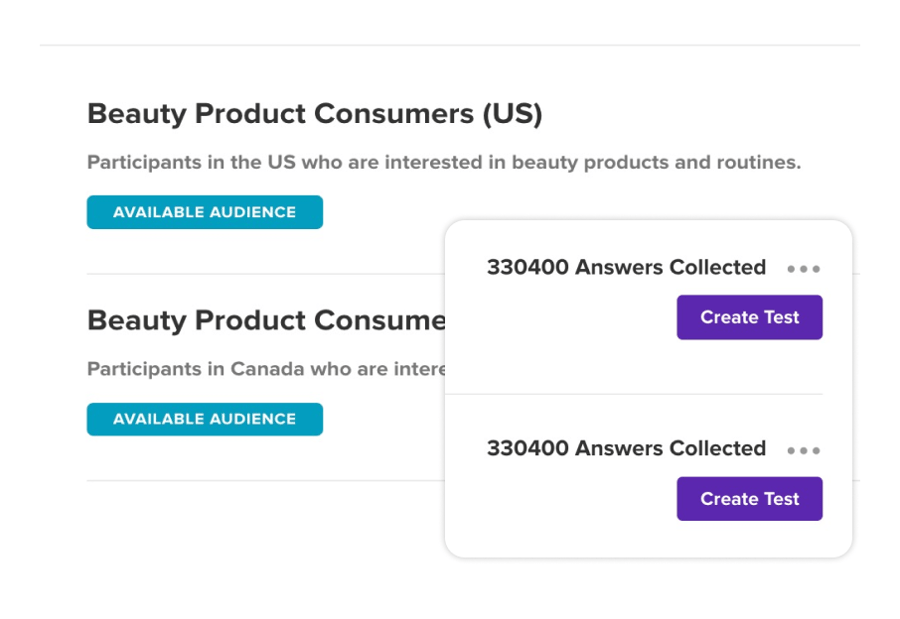Attract Customers by Understanding Their Journey
Delve into the depths of your customers’ behavior and preferences. Foundational research uncovers the critical moments and motivations that lead buyers to take action, helping you refine your strategies to attract and retain more customers.


Uncover Trigger Moments
Identify the specific events or circumstances that prompt customers to seek out your products or services, allowing you to target them more effectively.
Enhance Customer Personas
Develop richer, more detailed customer personas based on actual behavior and motivations, ensuring your marketing and product strategies resonate with your target audience.
Boost Customer Acquisition
Align your offerings and messaging with customer needs, leading to more effective marketing, higher conversion rates, and increased customer acquisition.
Map to UX Metrics
Brand Impressions
Reaction

Frequency of Use
Comprehension
Explore A Relevant Case Study
Find answers to business questions
These questions guide your landing page testing efforts to optimize user experience, increase conversions, and achieve your business goals.
To identify the events or circumstances that lead customers to seek out your products or services, utilize a combination of ethnographic studies, surveys, interviews, focus groups, and behavioral data analysis. These methods provide a comprehensive understanding of the triggers driving customer decisions, allowing you to target them more effectively.
For example, a survey conducted by Skin Savvy revealed that a significant number of participants rarely seek professional advice for skincare. However, 77% showed interest in more communication with their esthetician outside of appointments. This insight highlights the opportunity to enhance customer engagement by facilitating better pre-appointment communication.
By understanding such trigger moments, you can refine your strategies to align with customer needs and preferences, ultimately improving your ability to attract and retain customers.
To gain insight into how different customer segments perceive your brand and offerings, conduct both moderated and unmoderated studies on all of your segmented customer demographics. This approach helps capture varying perceptions across different groups. Additionally, using social listening tools to analyze how these segments discuss your brand online provides valuable insights into their opinions and sentiments.
For example, Skin Savvy used both unmoderated and moderated surveys to understand perceptions from providers and non-clients. Providers gave positive feedback on the app’s onboarding and loyalty programs, while non-clients appreciated the user-friendly interface but suggested improvements in the consultation form and learn section.
Combining these methods offers a comprehensive view, helping tailor your strategies to meet diverse needs. This way, you can refine your offerings and messaging to better resonate with each customer segment.
Common pain points or barriers customers face in their journey can be discovered by analyzing the entire customer journey through mapping to pinpoint stages where difficulties or frustrations occur. Helio can help accomplish this by highlighting sentiment throughout the journey, revealing specific areas of concern. For example, SkinSavvy learned through Helio that their repetitive consultation request form was a significant pain point for users.
Methods such as surveys, interviews, usability testing, and customer support feedback analysis are essential for identifying these pain points. SkinSavvy conducted surveys and reviewed feedback, uncovering that users found it frustrating to repeatedly provide personal information in their consultation request form.
Employing these methods, you can gather comprehensive data on user experiences and challenges. This data helps you understand and address these issues effectively, improving the overall customer journey and satisfaction. Helio’s tools can support this process, providing valuable insights and allowing you to tailor your strategies to better meet customer needs.
To determine which channels are most effective in reaching and converting your target audience, foundational research can be invaluable. Helio helps by highlighting sentiment throughout the customer journey, offering insights into platform preferences. For example, SkinSavvy discovered that their customers preferred using the website for booking appointments and personalizing services, while the app was popular for completing surveys and checking into appointments.
The methods used included analyzing engagement rates, conversion rates, and return on investment (ROI) through surveys and behavioral data analysis. These metrics helped identify the most effective channels.
You can replicate this by conducting A/B testing and customer surveys to gather detailed insights into channel performance. This approach ensures your marketing strategies are data-driven, aligning with user preferences to enhance engagement and conversion rates.
How to set up Foundation Research

Define Your Research Objectives
Clearly articulate what you want to learn about your customers and their journey.

Choose Your Research Methods
Select the most appropriate research methods for your objectives, such as surveys, interviews, ethnographic studies, or data analysis.

Conduct Your Research
Gather data on customer behavior, preferences, motivations, and perceptions.

Analyze Your Findings
Synthesize your data to uncover patterns and insights related to customer behavior and trigger moments.

Implement Changes
Use your insights to refine your product offerings, messaging, and marketing strategies to align with customer needs.

Monitor and Measure
Track relevant KPIs to measure the impact of your changes on customer acquisition and retention
The best research you can do is talk to people.
FAQs
Foundational research involves deeply investigating customer behavior, motivations, and preferences to inform long-term strategies.
Understanding the fundamental aspects of customer behavior helps in aligning products, services, and marketing strategies with customer needs, leading to more effective customer acquisition.
Common methods include surveys, interviews, ethnographic studies, and data analysis.
Foundational research seeks to understand the underlying motivations and behaviors of customers, providing insights that inform long-term strategies. In contrast, other research types might focus on more immediate or specific issues.
Challenges can include the time and resources required to conduct in-depth research and the need for skilled analysts to interpret complex data
Engage experienced researchers and analysts, validate findings across multiple data sources, and be mindful of biases that could influence interpretation.






